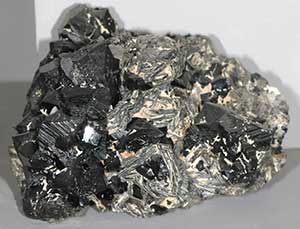Tin Ore
You will hardly find any pure form of tin in use, barring a few uses. Most of the tin that is extracted goes into the production of solder. This is used in welding and soldering metals. Another major use of tin is in making strong magnets that are used in electronics. These magnets are stronger than electromagnets that are 100 times heavier! Tin is also used as ingredients in making designer glasses, in painting and several therapeutic uses.
Tin coats applied on metals make the metal usable for food storage and uses that require immunity against the formation of bacteria or fungus. Tin powder is also used on wooden structures to protect it from fungus that waste wood.
In small amounts tin can be found in electrical components, food-grade containers, insecticides, fungicides, articles of daily use such as shaving foam and cosmetic products. In its pure form, tin is used to preserve and store chemicals and solutions that otherwise react with other metals.
| Atomic Symbol | : | Sn |
| Atomic Number | : | 50 |
| Element Category | : | Post-transition Metal |
| Density | : | 7.365g/cm3 |
| Melting Point | : | 231.9°C (449.5°F) |
| Boiling Point | : | 2602°C (4716°F) |
| Moh’s Hardness | : | 1.5 |

Tin is most often produced from the mineral cassiterite, which is made up of about 80% tin. Most tin is found in alluvial deposits, riverbeds, and former riverbeds, as a result of erosion of ore bodies containing the metal. China and Indonesia are currently the world's largest producers. Tin is smelted at temperatures of up to 2500°F (1370°C) with carbon to produce low purity tin and CO2 gas. It is then refined to high purity (>99%) tin metal through boiling, liquation, or electrolytic methods.
The use of tin alloys can be dated back many centuries. Bronze artifacts (bronze is an alloy of copper and tin), including hatchets, mirrors, and sickles, have been discovered in locations from present-day Egypt to China. Tin was also alloyed with lead for hundreds of years in order to make pewter kettles, pots, cups, and plates. Cognizant of the negative health effects of lead, pewter today is made from alloying tin, antimony, and cobalt. Tin-plated toys set the standard and were highly sought for their quality, from the mid-19th century through the mid-20th century. Plastic toys then became the norm.
Tin's more modern application is as a solder for the electronics industry. Used in various purities and alloys (often with lead or indium), tin solders have a low melting point, which makes them suitable for bonding materials. Tin alloys can also be found in a wide variety of other applications, including Babbitt bearings (often alloyed with copper, lead, or antimony), automobile parts (alloyed with iron), dental amalgams (alloyed with silver), and aerospace metals (alloyed with aluminum and titanium). Alloys of zirconium (often referred to as Zircaloys), used in nuclear reactors, also often contain a small amount of tin.
Many everyday items we associate with tin, such as "tin cans" and "tinfoil," are actually misnomers. Tin cans are, in fact, made from a compound referred to as tinplate, which is steel sheet metal that has been coated with a thin layer of tin. Tinplate efficiently combines the strength of steel with tin's luster, corrosion resistance, and low toxicity. That's why 90% of tinplate is used to make cans for food and drinks, cosmetics, fuel, oil, paints, and other chemicals. Although tin only makes up a small coating on tinplate, the industry is the largest consumer of tin worldwide. Tinfoil, on the other hand, may have been made from tin for a brief period during the 20th century, but today is exclusively made from aluminum.
Power by Enlink Trading Co. Pvt Ltd
Designed and Developed by Shopweb